
Station Name:CIRENCESTER WATERMOOR
| Date opened: |
18.12.1883 |
| Location: |
On south side of A419 |
| Company on opening: |
Swindon & Cheltenham Extension Railway |
| Date closed to passengers: |
11.9.1961 |
| Date closed completely: |
31.3.1964 |
| Company on closing: |
British Railways (Western Region) |
| Present state: |
Demolished - no trace of anything remains. The site is generally lost under a road and industry. The main station buildings and platforms were immediately east of the Watermoor Way roundabout on A429 (Bristol Road). The line crosses the road east of the roundabout and passes through the west end of the Capita Education Services building. The platforms started on the south side of Bristol Road, ran across the road and through the Capita building. The goods shed is in the middle of the roundabout. A little of the alignment survives on the south side of Bristol Road where a line of trees on a low embankment marks it. |
| County: |
Gloucestershire |
| OS Grid Ref: |
SP029010 |
| Date of visit: |
August 1967 |
 Notes: Cirencester station opened to passengers on 18 December 1883 (with a goods service running from 1 November), as the terminus of the 13½ mile Swindon and Cheltenham Extension Railway line from Swindon Town. There were intermediate stations at Rushey Platt (immediately south of the GWR line, with separate platforms on the curve to the GWR and the new main line), Cricklade and South Cerney. The S&CER was worked from the outset by the Swindon, Marlborough and Andover Railway. Notes: Cirencester station opened to passengers on 18 December 1883 (with a goods service running from 1 November), as the terminus of the 13½ mile Swindon and Cheltenham Extension Railway line from Swindon Town. There were intermediate stations at Rushey Platt (immediately south of the GWR line, with separate platforms on the curve to the GWR and the new main line), Cricklade and South Cerney. The S&CER was worked from the outset by the Swindon, Marlborough and Andover Railway.
The S&CER then amalgamated with the SM&AR on 23 June 1884 to form the Midland and South Western Junction Railway. The M&SWJR's network stretched from Cirencester to a junction with the Basingstoke and Salisbury Railway at Red Post Junction, Andover. Some work proceeded on the final section north to Cheltenham, but the Company was in serious financial difficulty and the contractor Watson, Smith and Watson went bankrupt in 1885. The M&SWJR was now unable to pay its bills and went into receivership in 1884, although it continued trading under the supervision of the Receiver in Chancery. In this desperate situation the only hope was to complete the through line, and the Company obtained authority to issue debenture stock in 1886 and again in 1887, and a contract was let to Charles Braddock. (Click here to see contractor's locomotive) He undertook to pay for the land acquisition and to pay some interest liabilities of the M&SWJR in return for £189,000 in perpetual 5% debenture stock.
 A token goods service to Dowdeswell was started on 16 March 1891. On 1 August 1891 the company finally completed negotiations to reach the Midland Railway station at Cheltenham station and the trains ran throughout at last, with through carriages to Southampton worked by the LSWR from Andover. Apart from the running arrangements over other lines, the new section consisted of 13¾ miles of single track; there were intermediate stations at Withington and Foss Cross with a third at Chedworth opening on 1 October 1892. A token goods service to Dowdeswell was started on 16 March 1891. On 1 August 1891 the company finally completed negotiations to reach the Midland Railway station at Cheltenham station and the trains ran throughout at last, with through carriages to Southampton worked by the LSWR from Andover. Apart from the running arrangements over other lines, the new section consisted of 13¾ miles of single track; there were intermediate stations at Withington and Foss Cross with a third at Chedworth opening on 1 October 1892.
Despite the size of the station, Cirencester Watermoor never achieved the passenger or goods traffic that was attracted by the Great Western station in the town, Cirencester Town. The station was named Cirencester Watermoor from 1924 to distinguish it from the GWR station.
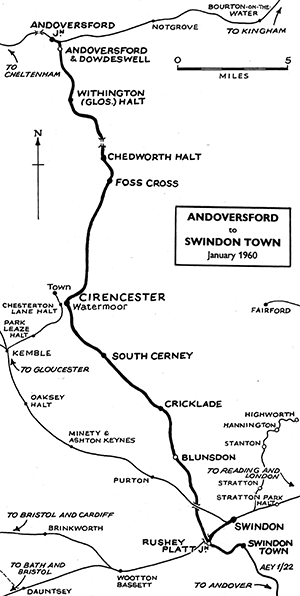 Cirencester was the biggest station on this section of the line; it had two facing platforms 322 feet in length on an embankment and on a curve. The main station building was on the up side with a large shelter on the opposite platform. The main station building was single storey and of stone construction with a pitched slate roof and a canopy stretching the full length of the building. The shelter on the down platform was clad in corrugated iron with an open section and a sloping roof that incorporated a canopy. Public access to the station was along a tree lined approach road from Chesterton Lane. Cirencester was the biggest station on this section of the line; it had two facing platforms 322 feet in length on an embankment and on a curve. The main station building was on the up side with a large shelter on the opposite platform. The main station building was single storey and of stone construction with a pitched slate roof and a canopy stretching the full length of the building. The shelter on the down platform was clad in corrugated iron with an open section and a sloping roof that incorporated a canopy. Public access to the station was along a tree lined approach road from Chesterton Lane.
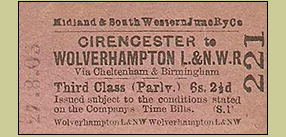
At the south end of the up platform there were three other buildings. First came a corrugated iron clad stationmaster's house, which in later years was used as an office. Then came a stone water tower. In 1912 the original water tower, seen in the first photo below, was given a larger tank of 50,000 gallons capacity. As well as providing water for locomotives, the tank also provided water for the stone quarry located to the south of Foss Cross, it being taken from Cirencester in rail mounted tankers. Water cranes were provided at the north end of the up platform and the south end of the down. The final building on the up platform was a signal box which, for all its life, was known as Cirencester Signal Cabin. A lamp room stood just beyond the south end of the up platform.
 The goods yard, which comprised four sidings, was located to the west and behind the up platform. The shortest siding served a 90ft long end loading goods dock behind the main station building. Two parallel sidings served the goods shed with one of them passing through the 100ft x 32ft shed. The shed had a 30cwt crane with the goods office located at its north end. The final siding served a 145ft cattle dock with pens. There were two weighbridges, one close to the entrance to the station at the bottom of the approach road, and the second close to the goods dock. The yard had a 5 ton capacity crane but it’s not sure where it was located, presumably on the dock. Entrance to the goods yard was from the station approach road with another entrance from Chesterton Road. The goods yard, which comprised four sidings, was located to the west and behind the up platform. The shortest siding served a 90ft long end loading goods dock behind the main station building. Two parallel sidings served the goods shed with one of them passing through the 100ft x 32ft shed. The shed had a 30cwt crane with the goods office located at its north end. The final siding served a 145ft cattle dock with pens. There were two weighbridges, one close to the entrance to the station at the bottom of the approach road, and the second close to the goods dock. The yard had a 5 ton capacity crane but it’s not sure where it was located, presumably on the dock. Entrance to the goods yard was from the station approach road with another entrance from Chesterton Road.
Beyond the goods yard the M&SWJR built a locomotive, carriage and wagon repair shop in 1883 and extended it in 1895. The workshops were further extended in 1915 with the addition of a body makers, paint and machine shop. Like many smaller railway companies the M&SWJR was never awash with money and the workshops were paid for by 'borrowing' from the Stock Fund, intended for locomotives. The company owned either 39 or 40 (sources vary) locomotives in total although not all at the same time. Entrance to the workshops was from Chesterton Road.
 After the Grouping the GWR closed the shops in 1925 and transferred the work to Swindon. For a time thereafter the GWR provided special trains to transport staff displaced at Cirencester to and from Swindon Works in the same manner as was later done on the nearby Highworth branch. By 1953 the site was in use by a scrap merchant and a coal merchant. The scrap yard eventually occupied the entire site. By the late 1950s the main works building had been partially demolished. After the Grouping the GWR closed the shops in 1925 and transferred the work to Swindon. For a time thereafter the GWR provided special trains to transport staff displaced at Cirencester to and from Swindon Works in the same manner as was later done on the nearby Highworth branch. By 1953 the site was in use by a scrap merchant and a coal merchant. The scrap yard eventually occupied the entire site. By the late 1950s the main works building had been partially demolished.
The final group of buildings west of the locomotive works and alongside Gas Lane was an engine shed and later a carriage shed. The OS maps reproduced below clearly show two sheds but Lyons and Mountford in their book An Historical Survey of Great Western Engine Sheds: 1837-1947 state there was only one 70ft X 20ft shed. A GWR map of the station shows one engine shed with a turntable and coal stage. A two road carriage shed was later built alongside the engine shed. The shed appear to have been out of use by 1920 and would have been redundant when the line was absorbed by the GWR in 1923, a photo from 1921 showing it was used for wagon storage with the carriage shed in use as a wagon repair shed.
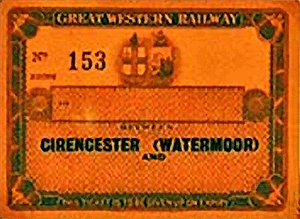
Prior to the arrival of the railway the Cirencester Gas Co. began operation in 1833 and was supplied by coal which was unloaded on a wharf on a branch of the nearby Thames and Severn Canal. With the arrival of the railway, the gasworks was rail connected. The gasworks had a narrow gauge tramway. The exact closure date of the gasworks is not clear. The Register of Defunct Companies states the Cirencester Gas Company was dissolved on 1 January 1937 under the Cirencester Gas Act. A new company using the same name, Cirencester Gas Company, was incorporated in 1937. In March 1948 the undertaking was acquired by Swindon United Gas Company and the Cirencester Gas Company was dissolved. Historic England however list the acquisition by the Swindon Gas Company as 1938 stating the works closed in 1939 with plant being removed to Swindon gasworks.
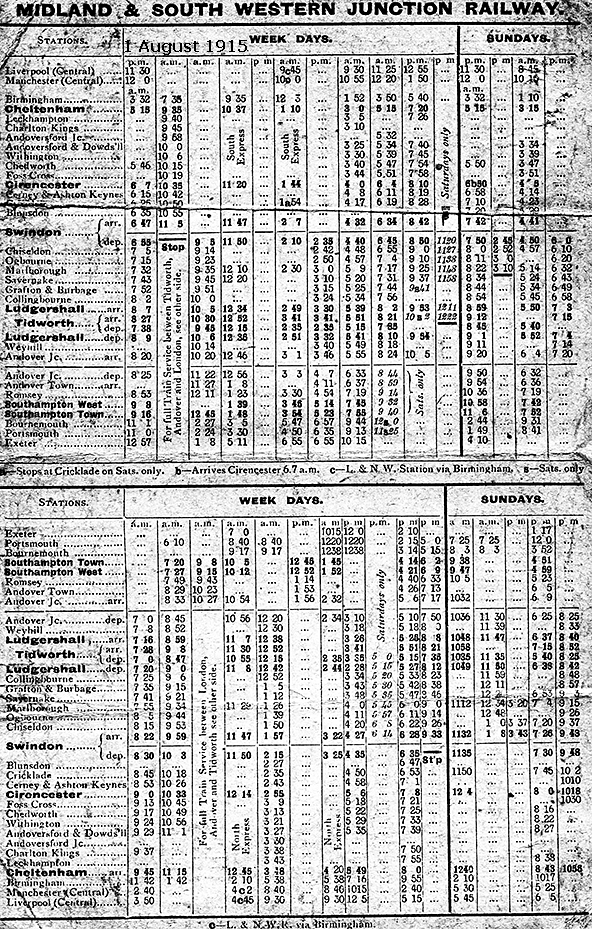
The 1904 Railway Clearing House Handbook of Stations lists no private sidings at Cirencester Watermoor but the 1956 handbook lists one siding belonging to South Western Gas Board. The Gas Board obviously still owned the siding even though the works had closed. Another private siding, alongside the Gas Board siding is listed as belonging to RA Lister and Co.
 During the Second World War anti-tank cubes were placed at the back of the southern end of the Down platform. In the war Cirencester became what was known as an 'anti-tank island', designed to hinder and divert an invasion force from the town into open country where further obstacles, natural and manmade, would hinder progress and make a counter attack more practical. Passenger and goods traffic on the former M&SWJR fell steeply after the war. During the Second World War anti-tank cubes were placed at the back of the southern end of the Down platform. In the war Cirencester became what was known as an 'anti-tank island', designed to hinder and divert an invasion force from the town into open country where further obstacles, natural and manmade, would hinder progress and make a counter attack more practical. Passenger and goods traffic on the former M&SWJR fell steeply after the war.
By summer 1959 the Up platform track was rusted and out of use. It would soon be lifted, with all trains thereafter using the Down platform. In March 1960 the Up line was lifted and the signal box was abolished and quickly demolished. With abolition of the box, Watermoor goods yard was controlled by a ground frame via a key attached to the South Cerney - Foss Cross train staff. From Monday 11 September 1961 Cirencester Watermoor station closed to passengers with the last service train running on Saturday 9 September. Two railtours were the last public trains to call at the station on Sunday 10 September. The RCTS ran their 'Farewell to the M&SWJR' railtour followed by the SLS 'Farewell to the M&SWJR' railtour which was stated to be the last passenger train in each direction over the northern half of the M$SWJR.
 While Watermoor station remained open, mainly for scrap traffic, the line between Cirencester and Andoversford Junction closed completely. Track lifting on this section, Andoversford Junction excluded, began in March 1963 and had reached Cirencester in May of that year. The contract had been awarded to Messrs. Pittrail of Aldridge, Staffordshire, using a Ruston & Hornsby 88DS diesel shunter and a Ruston - Bucyrus 22-RB crawler crane, the latter being hired from Messrs. Charles Jones, also of Aldridge. The contractor's base was at Foss Cross, to where complete track panels were taken for dismantling and disposal. Lifting was undertaken first southwards to Foss Cross and then northwards thereto from Cirencester. While Watermoor station remained open, mainly for scrap traffic, the line between Cirencester and Andoversford Junction closed completely. Track lifting on this section, Andoversford Junction excluded, began in March 1963 and had reached Cirencester in May of that year. The contract had been awarded to Messrs. Pittrail of Aldridge, Staffordshire, using a Ruston & Hornsby 88DS diesel shunter and a Ruston - Bucyrus 22-RB crawler crane, the latter being hired from Messrs. Charles Jones, also of Aldridge. The contractor's base was at Foss Cross, to where complete track panels were taken for dismantling and disposal. Lifting was undertaken first southwards to Foss Cross and then northwards thereto from Cirencester.
Diesel Hauled freight services between Swindon and Cirencester continued until 31 March 1964. After final closure the track was lifted back to Moredon Power Station in Swindon which remained rail served until 1969, with track lifted in 1978. The A429 Bristol Road (also known as the inner ring road) opened in 1975 so the scrap yard and what by then remained of Watermoor station would have been cleared in preparation circa 1973. The road cuts through the station site with the Watermoor roundabout on the site of the goods shed. Some of the degraded embankment still survives on the south side of Bristol Road but other than that, there is no evidence of the station, goods yard and workshops that once occupied the site.
 Tickets from Michael Stewart and Dave Bushell.. Route map drawn by Alan Young. Timetable from M&SWJR Odds and Ends Tickets from Michael Stewart and Dave Bushell.. Route map drawn by Alan Young. Timetable from M&SWJR Odds and Ends
See other web sites: Swindon's Other Railway which includes a superb collection of photos, documents, maps and film links relating to the M&SWJR. Also M&SWJR Odds and Ends - An excellent collection of photographs and ephemera.
Click here for a brief history of the Midland and South Western Junction Railway.
BIBLIOGRAPHY - Books:
- C G Maggs, 1967, The Midland and South Western Junction Railway, David &Charles
- D Barrett, B Bridgeman and D Bird, 1981, A M&SWJR Album, A Pictorial History of Swindon's 'Other'Railway, vol 1 1872 - 1899, Redbrick Publishers
- T B Sands, rev SC Jenkins, 1990, The Midland and South Western Junction Railway, Oakwood Press
- D Bartholomew, 1982, Midland and South Western Junction Railway, Volume 1, Wild Swan Press
- B Bridgeman, D Barrett and D Bird, 1990, Swindon's other Railway. The Midland and South Western Junction Railway 1900 - 1990, Alan Sutton and Redbrick
- M Barnsley, 1991, Midland and South Western Junction Railway, Volume 2 - Locomotives, Wild Swan Press
- B Bridgeman and M Barnsley, 1994, Midland and South Western Junction Railway, The Old Photographs Series, Alan Sutton
BIBLIOGRAPHY - Magazines:
- M Barnsley, HMRS J, vol 22 no 12, p 405, "Off the rails….the Cirencester - Fairford Road train"
- M Barnsley, HMSRJ, vol 23 no 3, p84, "Snapshots from Cirencester"
- D Barrett, Model Rail, January 2016, p 94, P4 model of Cirencester (Watermoor)
See also Cirencester Town
|
Cirencester Watermoor Gallery 1 c1910 - September 1953
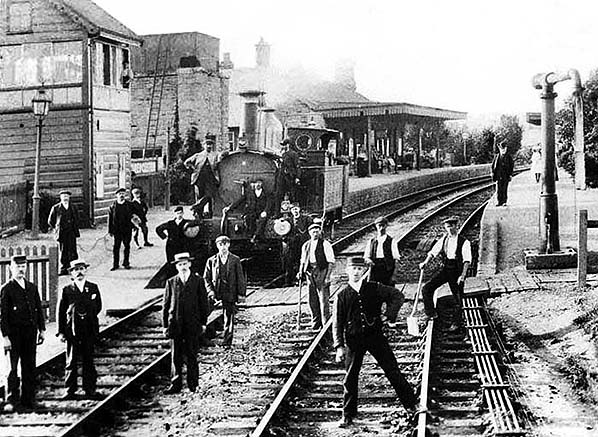 An early and obviously posed photograph with locomotive crew, track gangers, signalman and company officials visible. Partly obscured by the water crane, right, there are other people on the Down platform of which one is apparently a young female. Some difficulty has been experienced identifying the locomotive, with its polished brass dome, but it has been concluded with reasonable certainty that it is one of the Swindon, Marlborough & Andover Railway 2-4-0Ts numbered 5 - 7. These had been built by Messrs. Beyer, Peacock & Company (better known simply as Beyer Peacock) in 1884. The railway and its successor the M&SWJ had a number of Beyer Peacock tank locomotives to varying designs, the most obvious differences being in the design of the cabs and domes. Livery is difficult to determine but by the time of the photograph it was probably M&SWJ lined red with company initials and locomotive number on the sides of the tanks. One the three, No.6, ended up on the Isle of Wight Central Railway which had several of these Beyer Peacock tank locomotives to varying designs. No.6 became Isle of Wight Central No.7 and had replaced an earlier, withdrawn, No.7 which had been named 'Whippingham' but as far as is known the 'new' No.7 was never named. It was withdrawn by the Southern Railway in April 1925. Transfer to the island had occurred in December 1906 so it is reasonable to assume the M&SWJ withdrew all three locomotives prior to that date. From that assumption this view of Cirencester Watermoor likely dates from no later than 1906. There are some minor differences to the station in comparison with later views. The water tower is in its original, pre 1912, form and the addition of 'Watermoor' to the running-in board is still some years in the future. Token exchange apparatus has yet to appear as has any obvious sign of telegraph poles and wires. Between the water tower and locomotive chimney a window is visible, although it is not clear if the corrugated iron stationmaster's house, later altered and used as offices, was present at this time. The gas lamp was later relocated closer to the water tower and a telegraph pole took its place. On a perhaps amusing note, the valance of the Up platform canopy can be seen to have two missing sections. Whether they simply dropped off or were removed for a reason is not known, although photographs show various sections went missing and were replaced over the years. Other than these details the station was much the same as it was until 1960 when the signal box was abolished and the Up platform taken out of use.
Photo from Jim Lake collection
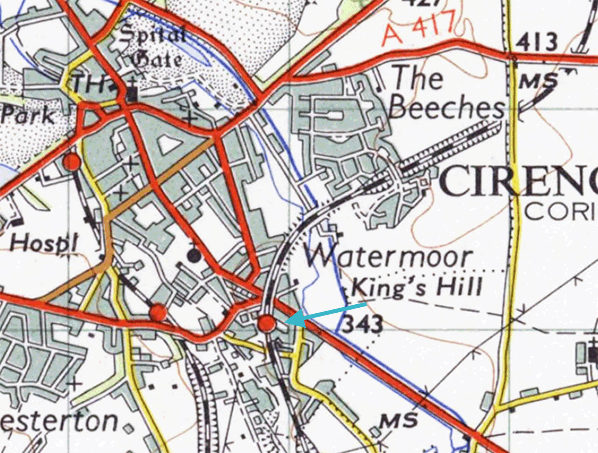
 1875 1:2,500 OS map shows the site of Cirencester Watermoor before the arrival of the railway. Until the railway came, Cirencester Gasworks was supplied by coal from a wharf on branch of the Thames and Severn Canal. There was an internal narrow gauge tramway which is seen. The Cirencester Town branch which opened in 1864 is seen on the left. 1875 1:2,500 OS map shows the site of Cirencester Watermoor before the arrival of the railway. Until the railway came, Cirencester Gasworks was supplied by coal from a wharf on branch of the Thames and Severn Canal. There was an internal narrow gauge tramway which is seen. The Cirencester Town branch which opened in 1864 is seen on the left.
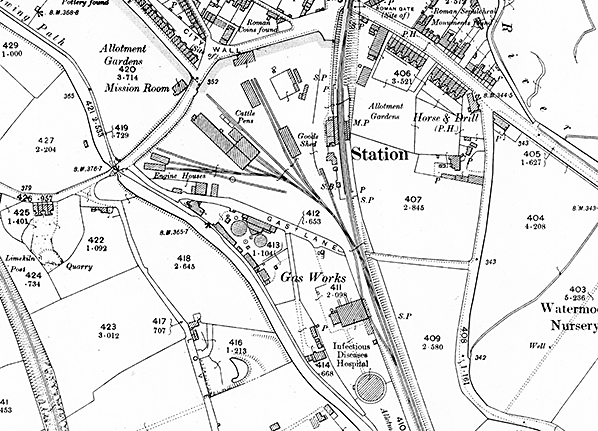
1902 1:2,500 OS map. The station opened in 1883 so this map shows the station and yard as built. The station is on a curve and a low embankment. Public access is along an access road running south from Chesterton Lane to the main station building on the up platform. A generous waiting shelter was provided opposite on the down platform. Passengers used a barrow crossing at the south end of the station to reach the up platform. The stationmaster's house is located on the down platform just south of the main station building with a water tower and signal box also being sited at the south end of the platform. The goods yard comprises four sidings to the west of the station, one short siding serving a dock behind the down platform. Another siding passes through the goods shed and another serves a cattle dock and pens. To the west of the goods yard is the M&SWJR locomotive, carriage and wagon repair shop. West of the works and to the north of Gas Lane, two engine sheds and a turntable are seen. This map is the only reference to two engine sheds. With the arrival of the railway Cirencester Gas works was extended closer to the railway and a new gasometer built on the south side of the works. A siding runs alongside the gasworks. Click here to enlarge. Click here to enlarge.
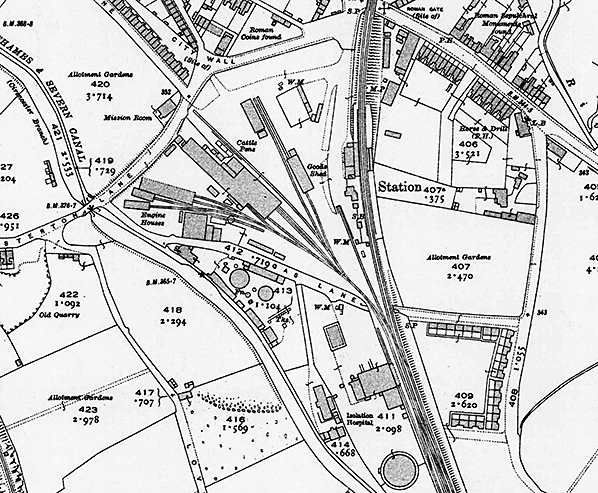
1921 1:2,500 OS Map. Cirencester Watermoor station is unchanged. There have been some changes to the goods yard and works. In the goods yard two weighbridges (WM) are now identified, one close to the entrance to the yard and a second near the goods dock. The M&SWJR works building has been extended with a machine shop being added to the west side of the building in 1915. A carriage shed has been added alongside the two engine sheds and an extra siding has been added alongside the gasworks. Click here to enlarge
old1.jpg)
A rather delightful view of Watermoor during M&SWJR days and sometime prior to 1912, the year in which the original water tower, as seen here, was given a larger tank of 50,000 gallons capacity. This was done to provide water for the stone quarry located to the south of Foss Cross, it being taken from Cirencester in tank wagons, as well as for locomotives. The 'Watermoor' suffix was yet to be added to the station name, this occurring in July 1924 following takeover by the Great Western Railway the previous year. The building behind the station at far left was the goods shed. The corrugated iron structure between the water tower and the station building was originally the stationmaster's house. It later became offices. Unusually for photographs from this period only one member of, presumably, staff is visible. This and the broom plus sweepings lying on the platform suggests the photograph was taken unexpectedly.
Copyright photo from John Alsop collection
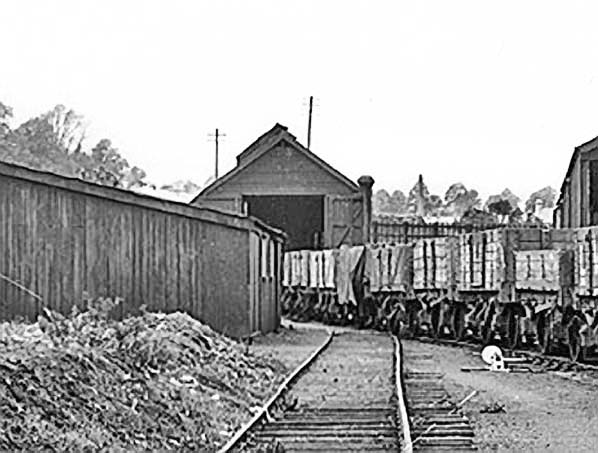
The only known picture of Cirencester Watermoor engine shed in 1921. The OS maps reproduced above clearly show two sheds but Lyons and Mountford in their book An Historical Survey of Great Western Engine Sheds: 1837-1947 state there was only one shed. It may be that two adjacent sheds were counted as one. It is assumed the shed was out of use by 1921 and would have been redundant when the line was absorbed by the GWR in 1923. From this view it seems that the tracks leading to the shed were used for wagon storage. A GWR plan shows the building on the right as a wagon repair shop. The photographer is standing on the turntable and coal stage road.
Photo from Roger Griffiths collection
watermoor_old33..jpg)
A poor quality but nevertheless interesting scene, likely dating from around 1930. Posing before the camera is a motor trolley for permanent way (PW) inspection. These were used by the foremen of the PW gangs and it is likely to be the local foreman seen here. The trolley would have been powered by a small petrol engine with, most likely at this time, a single cylinder or at best two cylinders. Air cooling was provided. Operation of such motor trolleys was controlled by a special set of rules referred to by the GWR as the 'Motor Trolley System'. Liaisons with signalmen were crucial for obvious reasons and track possession was effected by a special 'key instrument' at signal boxes, level crossings and other points. The obtaining of the key by the trolley driver locked the line out of use to all other traffic. On busy main lines the system differed but that described would have applied to the M&SWJ. When one sees these trolleys one understandably thinks 'Wickham' but this example cannot be positively identified, although the general layout is not far removed from that of the Wickham Type 14B. Each wheel has a splasher but being misaligned to the wheels they were probably more about protecting feet from revolving wheels. Of note is the lack of weather protection and the small bench seat on which the driver sat sideways; both these features being common for early trolleys. It appears the bench seat can accommodate two people. Removal from the track would be achieved simply by manhandling and the trolleys were deliberately designed to be light enough to facilitate this. Storage when not in use was normally in a small hut set at a right angle to the track but precisely where this particular trolley was kept is not known. In due course trolleys capable of carrying several men, along with trailers to carry tools and equipment, were introduced. The most familiar of these was the Wickham Type 17 in its various forms and they remained a common sight decades into British Railways days
Photo
from John Mann collection
old2.jpg) The facilities to the west side of Watermoor station as they were in 1931. At right is seen the goods dock, this being located on the west side of the Up platform and at its southern end. The building right of centre is the goods shed while in the centre of the photograph is the former M&SWJR locomotive, carriage and wagon repair shop. This facility dated from 1883 and was extended in 1895. The smaller building to the left was a machine shop, this being added in 1915. Like many smaller railway companies the M&SWJR was never awash with money and the workshops were paid for by 'borrowing' from the Stock Fund, intended for locomotives. The company owned either 39 or 40 (sources vary) locomotives in total although not all at the same time. The locomotive fleet was a somewhat motley but nonetheless interesting collection and well worth reading about. Visible are wagons of GWR, SR and LMS origin. In front of the two cattle wagons on the left is an open wagon belonging to the Cirencester Gas Co. Ltd. This company and Cirencester Gasworks are described elsewhere.
Copyright photo from John Alsop collection
old3.jpg) This view, looking north in 1935, is worth comparing with the pre 1912 photograph. The water tower now has the larger, 50,000 gallon, tank but the supporting structure will in due course be altered further with additional corner support. The corrugated iron building, originally the stationmaster's house, has undergone change and is now in use as offices. This view, looking north in 1935, is worth comparing with the pre 1912 photograph. The water tower now has the larger, 50,000 gallon, tank but the supporting structure will in due course be altered further with additional corner support. The corrugated iron building, originally the stationmaster's house, has undergone change and is now in use as offices.
Copyright photo from John Alsop collection
On an unknown date an unidentified GWR 43xx Class locomotive pauses at Watermoor with a Down passenger train, perhaps bound for Southampton Terminus. The locomotives still carries Great Western Railway livery while on the right can be seen the familiar wartime tank traps or, more correctly, 'anti-tank cubes'. A broad date window for this photograph will therefore be Second World War through to early British Railways days and probably closer to the latter.
Photo from John Mann collection
watermoor_old34..jpg)
On an unknown date No. 7818 'Granville Manor' waits at Watermoor beside the token exchange apparatus with a southbound train. She carries an early BR livery with original BTC/BR device on her tender and an 85B (Gloucester Horton Road) shedplate. Shedplates originated with the LMS and British Railways introduced them system-wide from 1950. No. 7818 remained at Horton Road until July 1952 so this scene could and likely does date from the 1950 - 1952 period. The livery of the train also supports this deduction. In the right background can be seen one of Watermoor's water cranes complete with anti-frost brazier while in the left background can just be seen the roof of Watermoor's goods shed.
Photo
from Jim Lake collection
old4.jpg) Cirencester's former locomotive, carriage and wagon repair shops seen here in September 1953. Watermoor station is out of view to the right. The GWR had, logically, closed these shops in 1925 and transferred the work to Swindon. For a time thereafter the GWR provided special trains to transport staff displaced at Cirencester to and from Swindon Works in the same manner as was later done on the nearby Highworth branch. By 1953 the site was in use by a scrap merchant and a coal merchant, right. The scrap yard would in due course occupy the entire site. The coal merchant's lorries appear to be an Austin K4, facing the camera, and a Fordson 7V. Among the pile of scrap, left of centre, can be seen a particularly ancient vehicle even for 1953. The building at far left, beyond the wagons, was a carriage shed. A turntable was also provided, its site being well out of view to the left. The loading gauge, right, is of the common GWR type with hinged ends. Their purpose was to check loadings of wagons destined for LMS lines as well as internal GWR movements. Cirencester's former locomotive, carriage and wagon repair shops seen here in September 1953. Watermoor station is out of view to the right. The GWR had, logically, closed these shops in 1925 and transferred the work to Swindon. For a time thereafter the GWR provided special trains to transport staff displaced at Cirencester to and from Swindon Works in the same manner as was later done on the nearby Highworth branch. By 1953 the site was in use by a scrap merchant and a coal merchant, right. The scrap yard would in due course occupy the entire site. The coal merchant's lorries appear to be an Austin K4, facing the camera, and a Fordson 7V. Among the pile of scrap, left of centre, can be seen a particularly ancient vehicle even for 1953. The building at far left, beyond the wagons, was a carriage shed. A turntable was also provided, its site being well out of view to the left. The loading gauge, right, is of the common GWR type with hinged ends. Their purpose was to check loadings of wagons destined for LMS lines as well as internal GWR movements.
Photo from John Mann collection
Click here for Cirencester Watermoor Gallery 2
6 May 1956 - 10 July 1959
 Home Page Home Page
| Last
updated: Saturday, 08-Jan-2022 11:48:34 CET | ©
1998-2022 Disused Stations | |



 1875 1:2,500 OS map shows the site of Cirencester Watermoor before the arrival of the railway. Until the railway came, Cirencester Gasworks was supplied by coal from a wharf on branch of the Thames and Severn Canal. There was an internal narrow gauge tramway which is seen. The Cirencester Town branch which opened in 1864 is seen on the left.
1875 1:2,500 OS map shows the site of Cirencester Watermoor before the arrival of the railway. Until the railway came, Cirencester Gasworks was supplied by coal from a wharf on branch of the Thames and Severn Canal. There was an internal narrow gauge tramway which is seen. The Cirencester Town branch which opened in 1864 is seen on the left.

old1.jpg)

watermoor_old33..jpg)
old2.jpg)
old3.jpg) This view, looking north in 1935, is worth comparing with the pre 1912 photograph. The water tower now has the larger, 50,000 gallon, tank but the supporting structure will in due course be altered further with additional corner support. The corrugated iron building, originally the stationmaster's house, has undergone change and is now in use as offices.
This view, looking north in 1935, is worth comparing with the pre 1912 photograph. The water tower now has the larger, 50,000 gallon, tank but the supporting structure will in due course be altered further with additional corner support. The corrugated iron building, originally the stationmaster's house, has undergone change and is now in use as offices.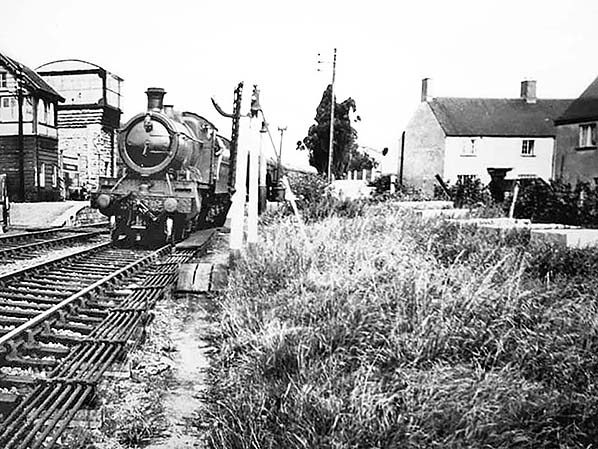
watermoor_old34..jpg)
 Home Page
Home Page  Notes: Cirencester station opened to passengers on 18 December 1883 (with a goods service running from 1 November), as the terminus of the 13½ mile Swindon and Cheltenham Extension Railway line from Swindon Town. There were intermediate stations at Rushey Platt (immediately south of the GWR line, with separate platforms on the curve to the GWR and the new main line), Cricklade and South Cerney. The S&CER was worked from the outset by the Swindon, Marlborough and Andover Railway.
Notes: Cirencester station opened to passengers on 18 December 1883 (with a goods service running from 1 November), as the terminus of the 13½ mile Swindon and Cheltenham Extension Railway line from Swindon Town. There were intermediate stations at Rushey Platt (immediately south of the GWR line, with separate platforms on the curve to the GWR and the new main line), Cricklade and South Cerney. The S&CER was worked from the outset by the Swindon, Marlborough and Andover Railway. A token goods service to Dowdeswell was started on 16 March 1891. On 1 August 1891 the company finally completed negotiations to reach the Midland Railway station at Cheltenham station and the trains ran throughout at last, with through carriages to Southampton worked by the LSWR from Andover. Apart from the running arrangements over other lines, the new section consisted of 13¾ miles of single track; there were intermediate stations at Withington and Foss Cross with a third at Chedworth opening on 1 October 1892.
A token goods service to Dowdeswell was started on 16 March 1891. On 1 August 1891 the company finally completed negotiations to reach the Midland Railway station at Cheltenham station and the trains ran throughout at last, with through carriages to Southampton worked by the LSWR from Andover. Apart from the running arrangements over other lines, the new section consisted of 13¾ miles of single track; there were intermediate stations at Withington and Foss Cross with a third at Chedworth opening on 1 October 1892.  Cirencester was the biggest station on this section of the line; it had two facing platforms 322 feet in length on an embankment and on a curve. The main station building was on the up side with a large shelter on the opposite platform. The main station building was single storey and of stone construction with a pitched slate roof and a canopy stretching the full length of the building. The shelter on the down platform was clad in corrugated iron with an open section and a sloping roof that incorporated a canopy. Public access to the station was along a tree lined approach road from Chesterton Lane.
Cirencester was the biggest station on this section of the line; it had two facing platforms 322 feet in length on an embankment and on a curve. The main station building was on the up side with a large shelter on the opposite platform. The main station building was single storey and of stone construction with a pitched slate roof and a canopy stretching the full length of the building. The shelter on the down platform was clad in corrugated iron with an open section and a sloping roof that incorporated a canopy. Public access to the station was along a tree lined approach road from Chesterton Lane. 
 The goods yard, which comprised four sidings, was located to the west and behind the up platform. The shortest siding served a 90ft long end loading goods dock behind the main station building. Two parallel sidings served the goods shed with one of them passing through the 100ft x 32ft shed. The shed had a 30cwt crane with the goods office located at its north end. The final siding served a 145ft cattle dock with pens. There were two weighbridges, one close to the entrance to the station at the bottom of the approach road, and the second close to the goods dock. The yard had a 5 ton capacity crane but it’s not sure where it was located, presumably on the dock. Entrance to the goods yard was from the station approach road with another entrance from Chesterton Road.
The goods yard, which comprised four sidings, was located to the west and behind the up platform. The shortest siding served a 90ft long end loading goods dock behind the main station building. Two parallel sidings served the goods shed with one of them passing through the 100ft x 32ft shed. The shed had a 30cwt crane with the goods office located at its north end. The final siding served a 145ft cattle dock with pens. There were two weighbridges, one close to the entrance to the station at the bottom of the approach road, and the second close to the goods dock. The yard had a 5 ton capacity crane but it’s not sure where it was located, presumably on the dock. Entrance to the goods yard was from the station approach road with another entrance from Chesterton Road. After the Grouping the GWR closed the shops in 1925 and transferred the work to Swindon. For a time thereafter the GWR provided special trains to transport staff displaced at Cirencester to and from Swindon Works in the same manner as was later done on the nearby Highworth branch. By 1953 the site was in use by a scrap merchant and a coal merchant. The scrap yard eventually occupied the entire site. By the late 1950s the main works building had been partially demolished.
After the Grouping the GWR closed the shops in 1925 and transferred the work to Swindon. For a time thereafter the GWR provided special trains to transport staff displaced at Cirencester to and from Swindon Works in the same manner as was later done on the nearby Highworth branch. By 1953 the site was in use by a scrap merchant and a coal merchant. The scrap yard eventually occupied the entire site. By the late 1950s the main works building had been partially demolished.

 During the Second World War anti-tank cubes were placed at the back of the southern end of the Down platform. In the war Cirencester became what was known as an 'anti-tank island', designed to hinder and divert an invasion force from the town into open country where further obstacles, natural and manmade, would hinder progress and make a counter attack more practical. Passenger and goods traffic on the former M&SWJR fell steeply after the war.
During the Second World War anti-tank cubes were placed at the back of the southern end of the Down platform. In the war Cirencester became what was known as an 'anti-tank island', designed to hinder and divert an invasion force from the town into open country where further obstacles, natural and manmade, would hinder progress and make a counter attack more practical. Passenger and goods traffic on the former M&SWJR fell steeply after the war. While Watermoor station remained open, mainly for scrap traffic, the line between Cirencester and Andoversford Junction closed completely. Track lifting on this section, Andoversford Junction excluded, began in March 1963 and had reached Cirencester in May of that year. The contract had been awarded to Messrs. Pittrail of Aldridge, Staffordshire, using a Ruston & Hornsby 88DS diesel shunter and a Ruston - Bucyrus 22-RB crawler crane, the latter being hired from Messrs. Charles Jones, also of Aldridge. The contractor's base was at Foss Cross, to where complete track panels were taken for dismantling and disposal. Lifting was undertaken first southwards to Foss Cross and then northwards thereto from Cirencester.
While Watermoor station remained open, mainly for scrap traffic, the line between Cirencester and Andoversford Junction closed completely. Track lifting on this section, Andoversford Junction excluded, began in March 1963 and had reached Cirencester in May of that year. The contract had been awarded to Messrs. Pittrail of Aldridge, Staffordshire, using a Ruston & Hornsby 88DS diesel shunter and a Ruston - Bucyrus 22-RB crawler crane, the latter being hired from Messrs. Charles Jones, also of Aldridge. The contractor's base was at Foss Cross, to where complete track panels were taken for dismantling and disposal. Lifting was undertaken first southwards to Foss Cross and then northwards thereto from Cirencester.  Tickets from Michael Stewart and Dave Bushell.. Route map drawn by Alan Young. Timetable from
Tickets from Michael Stewart and Dave Bushell.. Route map drawn by Alan Young. Timetable from 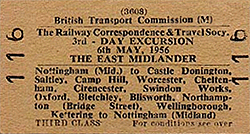

old4.jpg) Cirencester's former locomotive, carriage and wagon repair shops seen here in September 1953. Watermoor station is out of view to the right. The GWR had, logically, closed these shops in 1925 and transferred the work to Swindon. For a time thereafter the GWR provided special trains to transport staff displaced at Cirencester to and from Swindon Works in the same manner as was later done on the nearby Highworth branch. By 1953 the site was in use by a scrap merchant and a coal merchant, right. The scrap yard would in due course occupy the entire site. The coal merchant's lorries appear to be an Austin K4, facing the camera, and a Fordson 7V. Among the pile of scrap, left of centre, can be seen a particularly ancient vehicle even for 1953. The building at far left, beyond the wagons, was a carriage shed. A turntable was also provided, its site being well out of view to the left. The loading gauge, right, is of the common GWR type with hinged ends. Their purpose was to check loadings of wagons destined for LMS lines as well as internal GWR movements.
Cirencester's former locomotive, carriage and wagon repair shops seen here in September 1953. Watermoor station is out of view to the right. The GWR had, logically, closed these shops in 1925 and transferred the work to Swindon. For a time thereafter the GWR provided special trains to transport staff displaced at Cirencester to and from Swindon Works in the same manner as was later done on the nearby Highworth branch. By 1953 the site was in use by a scrap merchant and a coal merchant, right. The scrap yard would in due course occupy the entire site. The coal merchant's lorries appear to be an Austin K4, facing the camera, and a Fordson 7V. Among the pile of scrap, left of centre, can be seen a particularly ancient vehicle even for 1953. The building at far left, beyond the wagons, was a carriage shed. A turntable was also provided, its site being well out of view to the left. The loading gauge, right, is of the common GWR type with hinged ends. Their purpose was to check loadings of wagons destined for LMS lines as well as internal GWR movements.